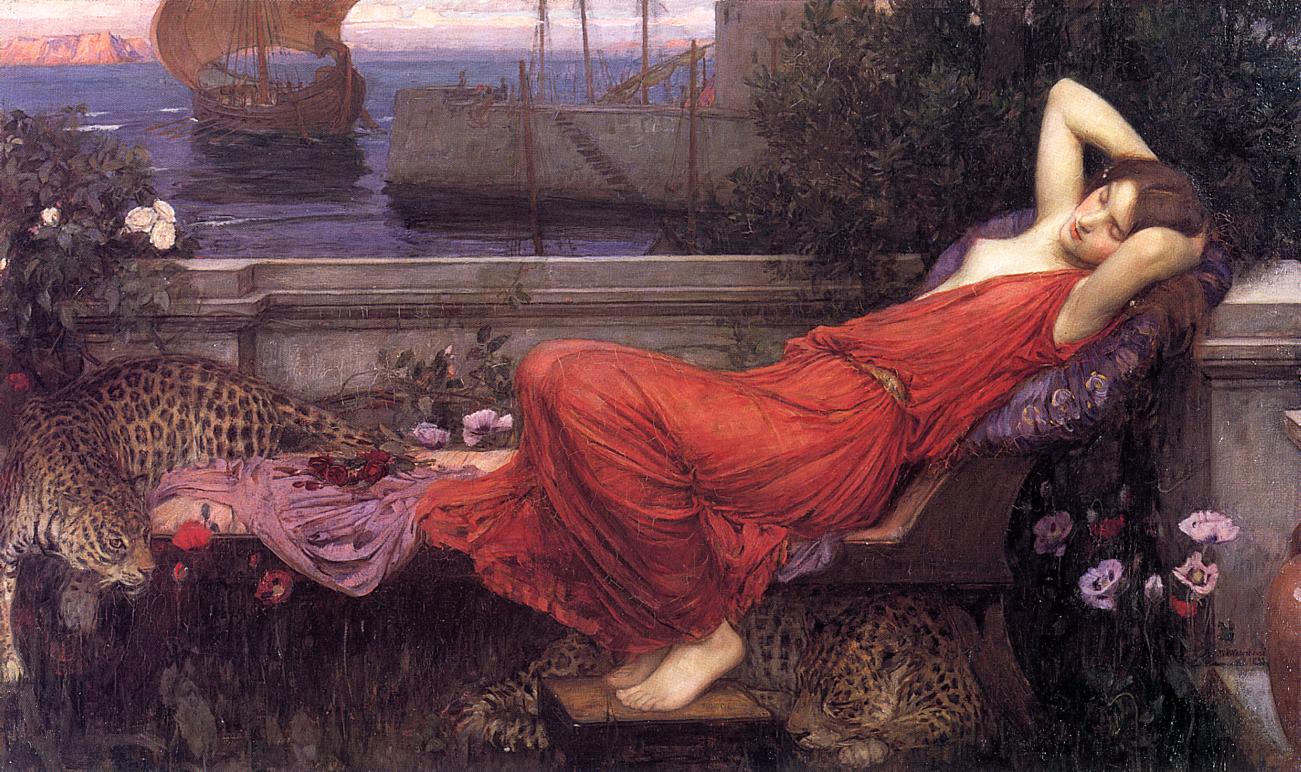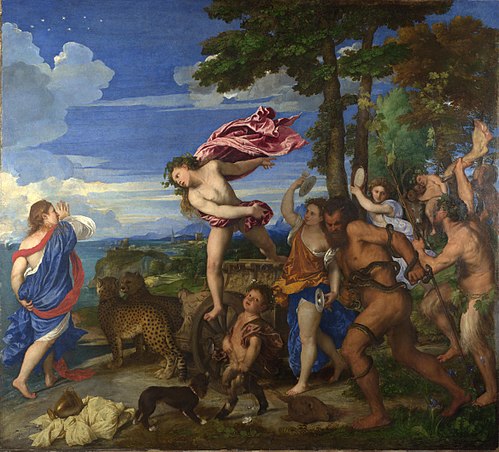Written by Mary Naples, Contributing Writer, Classical Wisdom
Make no mistake, unlike her previous manifestation in the Minoan pantheon (see: Part 1 and Part 2), Ariadne is now merely the wife of a fertility god. Myths abound about Dionysus’ exploits and adventures without Ariadne, yet when Ariadne is mentioned at all in these myths, it is only in relation to Dionysus.
When Dionysus returns to her, their marriage is made sacred each year amidst orgiastic celebrations—Ariadne is reborn, and the planet is made fruitful again. According to Walter Burkert’s seminal book Greek Religion, the celebration of the sacred marriage between Dionysus and Ariadne was called the Anthesteria and it commemorated the king, Theseus, giving his wife, Ariadne, to the god.
Moreover there were two Ariadne festivals on the island of Naxos, one joyful, the other mournful. “The marriage with Dionysus stands in the shadow of death,” Burkert affirms. As with all fertility festivals, death—an aspect of life’s regeneration, is implicated in the revelry.
Death calls again in another myth associated with the fertility couple when Dionysus finds himself at war with his nemesis—Perseus, King of Argo—and the Argives.
Perseus, it should be remembered, was made famous for beheading Medusa—while she slept. One of the three Gorgon sisters, Medusa’s gaze would turn men to stone. Some assert that Medusa may have once been a pre-patriarchal goddess herself, which could be reason enough for her slaying by the patriarch.
According to the epic poet Nonnus (circa 400-500 CE) in his Dionysiaca, a “frail,” and evidently mortal Ariadne, turned to stone when “raging Perseus” mistakenly strikes her in battle with a spear. There are, however, inconsistencies in the myths.
Time and again throughout these later myths, Ariadne is referred to as mortal even though in another tradition, Dionysus descended into the underworld to retrieve her and take her back with him to Olympus as his immortal wife. She proves, however, to be more mortal than immortal when, according to Pausanias, the goddess is laid to rest in an “earthenware coffin.”
Finally, again in Dionysiaca, Nonnus revives her weepy shade:
“Dionysos, you have forgotten your former bride: you long for Aura, and you care not for Ariadne. O my own Theseus, whom the bitter wind stole! O my own Theseus whom Phaedra (Ariadne’s sister) got for a husband! I suppose it was fated that a perjured husband must always run from me…..Alas, that I had not a mortal husband, one soon to die; then I might have armed myself against lovemad Dionysus…”
Diminished to a lovelorn phantom, Ariadne laments her fate at the hands of two unworthy males. Even her younger sister Phaedra’s miserably unhappy marriage to Theseus, is not enough to assuage her grief. Reduced to a woman whose only source of happiness is through a man, the shadow of Ariadne in 400-500 CE –when Nonnus penned these lines—is poles apart from the independent great mother goddess she once was, over two thousand years prior.
Honored in a religion of the soil that encouraged not only reverence for nature but respect for women, Ariadne became subjugated under a patriarchal society which relegated the female while exalting the male.
With her identity brought down, she was used as a foil for the men she would serve. Ariadne, however, was not the only great mother goddess thus subdued. Some believe that under the archetypal guises of the carnal Aphrodite, the jealous Hera and even the patriarchal Athena are vestiges of the great mother goddess tradition from whence they sprang.
Much scholarship has been done on the thesis that beneath the greater Olympic pantheon—as envisioned by Hesiod and Homer—lay the underpinnings of older great goddess religions. If read closely, this can be evident within Ariadne’s mythology when every so often, there is a glimpse into her primary manifestation, as it was envisioned once in the primordial mist of prehistory.
In spirals mimicking her labyrinth, the women whirled around dancing rhythmically. Their movements were designed to stimulate fecundity as they gesticulated and rotated in harmony with the planet’s own movement.
In the center of the circle was Ariadne’s priestess—her physical incarnation on earth. Steeped in pageantry, she was every bit the goddess, outfitted in layers of gold and a kaleidoscopic costume only a deity could pull off.
Designed to include adherents in an intimate setting with their deities, Minoan temples were as nonhierarchical as their society. Yet were the fertility festivals held in the temples or outdoors in the fresh air? Did the women chant as they danced around Ariadne’s persona? Were men involved in the ceremony? We can only guess. Even on a clear day, the view looking back over the span of epochs is hazy.
One thing remains certain, in the paramount and indispensable domain of fertility—the women were in charge.
Reference List for Parts 1, 2, and 3:
Brindel, J. 1980. Ariadne: A Novel of Ancient Crete. St. Martin’s Press.
Burkert, W. 1985. Greek Religion. Harvard University Press.
Eisner, R. 1977. Some Anomalies in the Myth of Ariadne. The Classical World. Vol. 71, No. 3.
Herberger, C. 1972. The Thread of Ariadne. Philosophical Library.
Perry, L. 2013. Ariadne’s Thread. Moon Books.
Rigoglioso, M. 2010. Virgin Goddesses of Antiquity. Palgrave Macmillan.
Webster, T. 1966. The Myth of Ariadne from Homer to Catullus. Greece & Rome. Vol. 13, No. 1.












No comments yet. You should be kind and add one!
Our apologies, you must be logged in to post a comment.